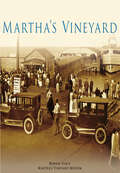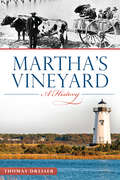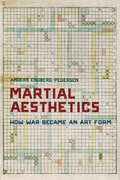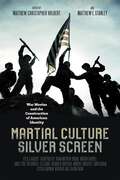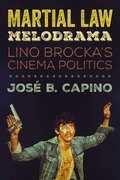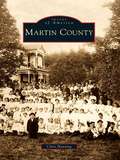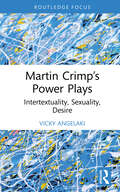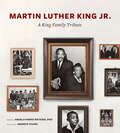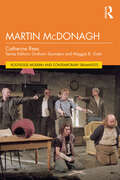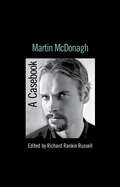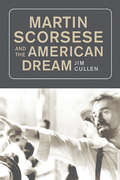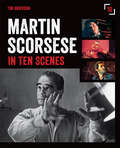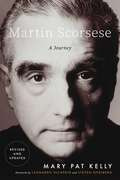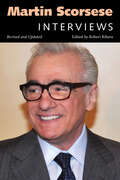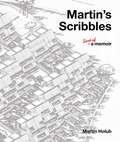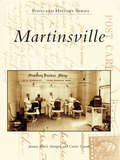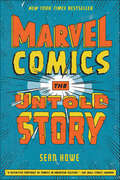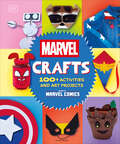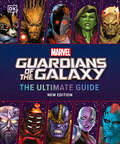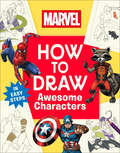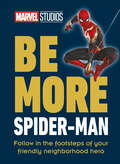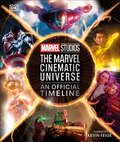- Table View
- List View
Martha's Vineyard (Images of America)
by Bonnie StacyThis stunning volume illustrates the history of the island from whaling hub to summer paradise with more than 200 vintage images. During the nineteenth century, seafaring industries dominated the economy of Martha&’s Vineyard, with busy harbors hosting thousands of ships as they put in for refitting, supplies, and crew members. As the whaling boom diminished, religious revivalism and then tourism brought more and more summer visitors. By the twentieth century, the now familiar yearly cycle of quiet winters alternating with enormous bursts of activity and population in the summers was well established. Bonnie Stacy, chief curator of the Martha&’s Vineyard Museum, has selected images from the museum&’s extensive photograph collection to illustrate the history of the island. This collection, donated through the generosity of islanders and visitors over the course of more than ninety years, represents an invaluable record of the Vineyard from the 1840s to the present day.
Martha's Vineyard: A History (Brief History)
by Thomas DresserMartha's Vineyard is cherished by many as a summer paradise, but few know of its rich past. Descendants of the first Native American inhabitants still reside on the Vineyard. Once a critical whaling hub, the island's success drew in newcomers from around the world. Following the Civil War, land developers set their sights on attracting tourists to the island's scenic beaches, and soon thereafter, a visit from President Grant established Martha's Vineyard as a vacation haven. From a movement to secede from Massachusetts to the making of the summer blockbuster Jaws, author Thomas Dresser weaves together the threads of the Vineyard's fascinating history. Discover how this remarkable island adapted to the times and came to be one of the most sought-out vacation destinations on the East Coast.
Martial Aesthetics: How War Became an Art Form
by Anders Engberg-PedersenThe twenty-first century has witnessed a pervasive militarization of aesthetics with Western military institutions co-opting the creative worldmaking of art and merging it with the destructive forces of warfare. In Martial Aesthetics, Anders Engberg-Pedersen examines the origins of this unlikely merger, showing that today's creative warfare is merely the extension of a historical development that began long ago. Indeed, the emergence of martial aesthetics harkens back to a series of inventions, ideas, and debates in the eighteenth and early nineteenth century. Already then, military thinkers and inventors adopted ideas from the field of aesthetics about the nature, purpose, and force of art and retooled them into innovative military technologies and a new theory that conceptualized war not merely as a practical art, but as an aesthetic art form. This book shows how military discourses and early war media such as star charts, horoscopes, and the Prussian wargame were entangled with ideas of creativity, genius, and possible worlds in philosophy and aesthetic theory (by thinkers such as Leibniz, Baumgarten, Kant, and Schiller) in order to trace the emergence of martial aesthetics. Adopting an approach that is simultaneously historical and theoretical, Engberg-Pedersen presents a new frame for understanding war in the twenty-first century.
Martial Culture, Silver Screen: War Movies and the Construction of American Identity
by Liz Clarke Jason Phillips Brian Matthew Jordan David Kieran Andrew Graybill Kylie A. Hulbert James Trae" Welborn III Jessica Chapman Meredith Lair Andrew C. McKevitt Richard N. Grippaldi Calvin FaganMartial Culture, Silver Screen analyzes war movies, one of the most popular genres in American cinema, for what they reveal about the narratives and ideologies that shape U.S. national identity. Edited by Matthew Christopher Hulbert and Matthew E. Stanley, this volume explores the extent to which the motion picture industry, particularly Hollywood, has played an outsized role in the construction and evolution of American self-definition.Moving chronologically, eleven essays highlight cinematic versions of military and cultural conflicts spanning from the American Revolution to the War on Terror. Each focuses on a selection of films about a specific war or historical period, often foregrounding recent productions that remain understudied in the critical literature on cinema, history, and cultural memory. Scrutinizing cinema through the lens of nationalism and its “invention of tradition,” Martial Culture, Silver Screen considers how movies possess the power to frame ideologies, provide social coherence, betray collective neuroses and fears, construct narratives of victimhood or heroism, forge communities of remembrance, and cement tradition and convention. Hollywood war films routinely present broad, identifiable narratives—such as that of the rugged pioneer or the “good war”—through which filmmakers invent representations of the past, establishing narratives that advance discrete social and political functions in the present. As a result, cinematic versions of wartime conflicts condition and reinforce popular understandings of American national character as it relates to violence, individualism, democracy, militarism, capitalism, masculinity, race, class, and empire.Approaching war movies as identity-forging apparatuses and tools of social power, Martial Culture, Silver Screen lays bare how cinematic versions of warfare have helped define for audiences what it means to be American.
Martial Law Melodrama: Lino Brocka’s Cinema Politics
by José B. CapinoLino Brocka (1939–1991) was one of Asia and the Global South’s most celebrated filmmakers. A versatile talent, he was at once a bankable director of genre movies, an internationally acclaimed auteur of social films, a pioneer of queer cinema, and an outspoken critic of Ferdinand Marcos’s autocratic regime. José B. Capino examines the figuration of politics in the Filipino director’s movies, illuminating their historical contexts, allegorical tropes, and social critiques. Combining eye-opening archival research with fresh interpretations of over fifteen of Brocka’s major and minor works, Martial Law Melodrama does more than reveal the breadth of his political vision. It also offers a timely lesson about popular cinema’s vital role in the struggle for democracy.
Martin County (Images of America)
by Chris HanningWhen the first settlers arrived in Martin County in March 1856, the county was part of Brown and Faribault Counties. Perhaps these settlers heard the stories told by soldiers who passed through the region. They spoke of the many lakes and streams of clear water and abundant fish and waterfowl, ever-popular fur-bearing mammals, and timber stands where elk, deer, and buffalo foraged. Word spread fast, and by the winter of 1856-1857, the population of Martin County exploded to 20 men, 9 women, and 23 children. Martin County provides a visual record of the many cities in the county, from Dunnell to Truman and back down to East Chain and all the rest in between. There are photographs of the blizzard of 1881, a 1918 Red Cross auction, men balancing on telephone poles, and much more.
Martin Crimp’s Power Plays: Intertextuality, Sexuality, Desire (Routledge Advances in Theatre & Performance Studies)
by Vicky AngelakiThis book covers playwright Martin Crimp’s recent work showing how it captures the nuances in our interpersonal contemporary experience. Examining the bold and exciting body of writing by Crimp, the book delves into his depiction of intersections between narratives, as well as between private and public, through an honest look at power structures and shifts, marriages and relationships, sexuality, and desire. This book will be of great interest to students and scholars in Drama, Theatre and Performance, English Literature, and Opera Studies.
Martin Luther King Jr.: A King Family Tribute
by Angela Farris Watkins and Andrew YoungIn this “handsome photo-essay . . . family members across generations and a few close friends remember the man they knew as ‘M. L.’” (Booklist).Martin Luther King Jr.’s family comes together for the first time to share their reflections and memories of the great civil rights leader in this touching and intimate volume. Included are contributions from his sister (the only surviving member of his immediate family), his children, his in-laws, his nieces and nephews, and even his grandchildren, who, although they never met him, explain what his legacy means to them. Unlike the iconic persona of statues and portraits, the book presents a loving view of the man who used to sneaking naps during holiday meals and playing games with his nieces and nephews. Alongside these tributes are never-before-published family photos of Dr. King, as well as new photographs of the memorial dedicated to him in August 2011 on the National Mall in Washington, D.C.
Martin McDonagh (Routledge Modern and Contemporary Dramatists)
by Catherine ReesThis comprehensive, accessible introduction to one of Britain’s leading contemporary playwrights and filmmakers outlines Martin McDonagh’s body of work, the key critical contexts for understanding and exploring his career, analysis of productions, and includes an exclusive interview with the director of his most recent stage work. Analysis of McDonagh’s writing is broken down into three periods – his early Irish plays, his screenplays, and his later plays that move away from and outside of Ireland. Works are discussed thematically, giving a dynamic reading of the scripts and the ideas around which they circle. The book’s final section then delves in more detail into selected seminal productions of McDonagh’s writing, outlining key phases and transitions in his career.Part of the Routledge Modern and Contemporary Dramatists series, Martin McDonagh is an essential guide for scholars and students who are setting out to understand the life and work of one of the most popular and acclaimed British dramatists and filmmakers of the twenty-first century.
Martin McDonagh: A Casebook (Casebooks on Modern Dramatists)
by Richard Rankin RussellThis book represents the first collection of original critical material on Martin McDonagh, one of the most celebrated young playwrights of the last decade. Credited with reinvigorating contemporary Irish drama, his dark, despairing comedies have been performed extensively both on Broadway and in the West End, culminating in an Olivier Award for the The Pillowman and an Academy Award for his short film Six Shooter. In Martin McDonagh, Richard Rankin Russell brings together a variety of theoretical perspectives – from globalization to the gothic – to survey McDonagh’s plays in unprecedented critical depth. Specially commissioned essays cover topics such as identity politics, the shadow of violence and the role of Catholicism in the work of this most precocious of contemporary dramatists. Contributors: Marion Castleberry, Brian Cliff, Joan Fitzpatrick Dean, Maria Doyle, Laura Eldred, José Lanters, Patrick Lonergan, Stephanie Pocock, Richard Rankin Russell, Karen Vandevelde
Martin Scorsese and the American Dream
by Jim CullenMore than perhaps any other major filmmaker, Martin Scorsese has grappled with the idea of the American Dream. His movies are full of working-class strivers hoping for a better life, from the titular waitress and aspiring singer of Alice Doesn’t Live Here Anymore to the scrappy Irish immigrants of Gangs of New York. And in films as varied as Casino, The Aviator, and The Wolf of Wall Street, he vividly displays the glamour and power that can come with the fulfillment of that dream, but he also shows how it can turn into a nightmare of violence, corruption, and greed. This book is the first study of Scorsese’s profound ambivalence toward the American Dream, the ways it drives some men and women to aspire to greatness, but leaves others seduced and abandoned. Showing that Scorsese understands the American dream in terms of a tension between provincialism and cosmopolitanism, Jim Cullen offers a new lens through which to view such seemingly atypical Scorsese films as The Age of Innocence, Hugo, and Kundun. Fast-paced, instructive, and resonant, Martin Scorsese and the American Dream illuminates an important dimension of our national life and how a great artist has brought it into focus.
Martin Scorsese in 10 Scenes: The Stories Behind The Key Moments Of Cinematic Genius
by Tim GriersonMartin Scorsese in Ten Scenes takes an intriguing look at the life’s work of one of the world’s greatest filmmakers. Boiling down the Oscar-winner’s career to ten indelible scenes, this beautiful, full color collection examines Scorsese’s trademark techniques while offering critical analysis, filmmaking tips, and firsthand accounts from the cast and crew. An essential read for filmmakers, film students, and movie fans, this engaging and accessible book makes use of previously unreleased, behind-the-scenes material to present a multi-faceted view of each scene. With selections from Raging Bull, The King of Comedy, Goodfellas, and The Departed, Martin Scorsese in Ten Scenes provides an insightful, inspiring examination of a man whose films have influenced generations of moviegoers and filmmakers.
Martin Scorsese: A Journey
by Mary Pat KellyIn time for Scorsese&’s 80th birthday and the release of Killers of the Flower Moon, a new edition of the seminal oral history tracing Scorsese&’s journey from young filmmaker to legend, featuring a foreword by Steven Spielberg Few filmmakers, if any, make the kind of impact that Martin Scorsese has made on American cinema. The winner of every prestigious film award, including the Oscar, Scorsese is a living legend. Bestselling author and award-winning filmmaker Mary Pat Kelly&’s groundbreaking biography reveals how this working-class boy from Manhattan&’s Little Italy became one of our most acclaimed, celebrated, and influential filmmakers.Martin Scorsese: A Journey maps Scorsese&’s personal and artistic evolution though his films, from early works like student films and Mean Streets through cinematic masterpieces like Taxi Driver, Raging Bull,The King of Comedy,Goodfellas. Across interviews with Scorsese himself; stars like Robert De Niro, Paul Newman, Liza Minelli, and Nick Nolte; colleagues including screenwriters and cinematographers; as well as family and friends, it reveals the story of a man in a way that only his community and fellow artists can, giving us unprecedented, intimate access to the making of these iconic films and the extraordinary mind behind them. Brimming with insight into Scorsese&’s life, values, process, humor, and inspirations, it is a remarkable account of America&’s premiere director, the shepherd of countless imaginations.
Martin Scorsese: Interviews, Revised and Updated (Conversations with Filmmakers Series)
by Robert RiberaMartin Scorsese (b. 1942) has long been considered one of America’s greatest cinematic storytellers. Over the last fifty years he has created some of the most iconic moments in American film, never afraid to confront controversial issues with passion. While few of his films are directly autobiographical, his upbringing in New York’s Little Italy, the childhood asthma that kept him from playing sports, and his early desire to enter the priesthood all helped form his sensibilities and later shaped his distinct style. Community, religion, violence—these themes drive a Scorsese picture, and whether he examines the violence that bursts forth in the hand of Travis Bickle or the passion of Jesus Christ, Scorsese’s mastery of the history, art, and craft of filmmaking is undeniable. This collection was originally edited by the late Peter Brunette in 1999 and is now revised and extensively updated by Robert Ribera. It traces Scorsese’s evolution from the earliest days of the New American Cinema, his work with Roger Corman, and his days at New York University’s film program to his efforts to preserve the legacy of cinema, his documentary work, and his recent string of successes. Among new movies discussed are The Departed, Hugo, and The Wolf of Wall Street, and the documentaries No Direction Home and The Blues. Scorsese stands out as a director, producer, scholar, preservationist, and icon. His work both behind the camera and in the service of its history are a cornerstone of American and world cinemas. In these interviews, Scorsese takes us from Elizabeth Street to the heights of Hollywood and all the journeys in between.
Martin's Scribbles: Sort of a Memoir
by Martin HolubWhat do Prague, London, New York and Tehran have in common? Award-winning architect Martin Holub has lived, designed buildings and enriched lives in all these places. Martin&’s Scribbles is a travel memoir, meets architect biography, meets lifetime reflection. Readers are taken on a playful romp through the latter twentieth-century to the present, as seen through the eyes of Holub – from a schoolboy in Czechoslovakia with an imprisoned mother, to an expat and lively architect living, working and socializing in New York City. A collection of autobiographical short stories, Martin&’s Scribbles is an entertaining account of Holub&’s experiences in his 80 years of travel, architecture, love and expat life; at times hilarious and others heartbreaking. This most unlikely memoir provides a very personal and intimate witness of the world&’s recent history through the anecdotes and reflections of a well-traveled man, husband and architect. Holub&’s creative visualization of memorable moments and influential meetings evoke a feeling of nostalgia for one&’s own past experiences, and are told as only Holub himself could tell them.
Martinsville (Postcard History)
by Joanne Raetz Stuttgen Curtis TomakBased on vintage postcards, this new book is a unique and welcome addition to the small number of works devoted to the history of Martinsville. Captured here in more than 220 postcard images is an important chronicle of the past 100 years in the "City of Mineral Water." This visual record showcases the sanitariums--including the glorious Home Lawn and its sibling, the Martinsville--industries and businesses, buildings and people, courthouse square, and special events that shaped the past and influenced the present. This fascinating retrospective is an indispensable companion to and expansion of Morgan County, the authors' first book in Arcadia's Postcard History Series.
Martyrs and Players in Early Modern England: Tragedy, Religion and Violence on Stage (Studies in Performance and Early Modern Drama)
by David K. AndersonFocusing on Christopher Marlowe, William Shakespeare, John Webster and John Milton, Martyrs and Players in Early Modern England argues that the English tragedians reflected an unease within the culture to acts of religious violence. David Anderson explores a link between the unstable emotional response of society to religious executions in the Tudor-Stuart period, and the revival of tragic drama as a major cultural form for the first time since classical antiquity. Placing John Foxe at the center of his historical argument, Anderson argues that Foxe’s Book of Martyrs exerted a profound effect on the social conscience of English Protestantism in his own time and for the next century. While scholars have in recent years discussed the impact of Foxe and the martyrs on the period’s literature, this book is the first to examine how these most vivid symbols of Reformation-era violence influenced the makers of tragedy. As the persecuting and the persecuted churches collided over the martyr’s body, Anderson posits, stress fractures ran through the culture and into the playhouse; in their depictions of violence, the early modern tragedians focused on the ethical confrontation between collective power and the individual sufferer. Martyrs and Players in Early Modern England sheds new light on the particular emotional energy of Tudor-Stuart tragedy, and helps explain why the genre reemerged at this time.
Marvel Arms and Armor: The Mightiest Weapons and Technology in the Universe
by Nick JonesWho is Iron Man without his armor, or Thor without his hammer? Learn about the mightiest weapons ever made!From Iron Man&’s armor to Cap&’s shield and Star-Lord blasters to Gamora&’s godslayer, the Marvel universe is filled with iconic weapons, armor, and technology. Wielded by some of the greatest heroes and villains ever created, many of these objects have histories just as compelling as the characters who use them. Some are high-tech, futuristic creations; others have mystical origins. A few have destroyed worlds or sent entire empires crashing into dust. This is their story.© 2023 MARVEL
Marvel Comics: The Untold Story
by Sean HoweThe defining, behind-the-scenes chronicle of one of the most extraordinary, beloved, and dominant pop cultural entities in America’s history -- Marvel Comics – and the outsized personalities who made Marvel including Martin Goodman, Stan Lee, and Jack Kirby. “Sean Howe’s history of Marvel makes a compulsively readable, riotous and heartbreaking version of my favorite story, that of how a bunch of weirdoes changed the world…That it’s all true is just frosting on the cake.” —Jonathan LethemFor the first time, Marvel Comics tells the stories of the men who made Marvel: Martin Goodman, the self-made publisher who forayed into comics after a get-rich-quick tip in 1939, Stan Lee, the energetic editor who would shepherd the company through thick and thin for decades and Jack Kirby, the WWII veteran who would co-create Captain America in 1940 and, twenty years later, developed with Lee the bulk of the company’s marquee characters in a three-year frenzy. Incorporating more than one hundred original interviews with those who worked behind the scenes at Marvel over a seventy-year-span, Marvel Comics packs anecdotes and analysis into a gripping narrative of how a small group of people on the cusp of failure created one of the most enduring pop cultural forces in contemporary America.
Marvel Crafts: 100+ Activities and Art Projects Inspired by Marvel Comics
by DKCalling all crafters and wannabe Super Heroes alike! Features 100+ creative projects and activities, including art, puzzles, games, papercraft, and more.With photography and clear step-by-step, illustrated instructions, Marvel Crafts guides you through each project, enabling you to craft your way through exciting projects that will spark creativity and bring your love of Marvel Comics to life!Enjoy making creations themed around your favorite Marvel Super Heroes, including:Create your own Avengers masksDoc Ock’s pool noodle tentaclesMs. Marvel’s stretchy slimeCaptain America’s shield flying discThis activity book features extension tips to add to your creations, handy template pages at the back of the book, and beloved characters such as Spider-Man, Black Panther, Ms. Marvel, Hulk, Black Widow, Captain America, and many more.This is the perfect gift for Marvel fans ages 7-10 to get their creativity flowing and their imaginations soaring!© 2025 MARVEL
Marvel Guardians of the Galaxy The Ultimate Guide New Edition
by Nick JonesUncover the full story of the galaxy's most heroic band of misfits.Even since the 2000s, Marvel's greatest band of intergalactic outlaws have become ever more crucial to the comic book Marvel Universe and its key story lines, ultimately inspiring their inclusion in the Marvel Cinematic Universe with the blockbuster Guardians of the Galaxy movies. Fans all over the world have enjoyed their comics and movie adventures, and many will be wondering how the Guardians came to be the galaxy's most wanted crew of cosmic rogues. This new, updated, and expanded edition of the Guardians of the Galaxy Ultimate Guide gives the lowdown on the motley team's entire story, from their earliest incarnations to their latest story lines and future legacy. Chronicled by Marvel-approved comics experts and illustrated with stellar comic artwork, this is a must-have guide for die-hard fans and newcomers alike. © 2022 MARVEL
Marvel How to Draw Awesome Characters
by DKArtists of all skill levels – get ready for an exciting artistic journey as you learn how to draw the world’s most powerful Super Heroes and Villains!This 144-page how to draw book includes drawing projects for Iron Man, Captain America, Black Widow, Hulk, Thor, Ant-Man, Black Panther, Captain Marvel, and many more. Just grab a pencil and a piece of paper, then flip through the pages of beloved Marvel characters to find the one you want to draw.Build your artistic confidence as you learn to draw iconic Marvel characters:Features classic and recent Marvel characters – there’s something for everyone!Learn about art tools and materials, with a series of drawing exercises to teach young artists basic techniquesEasy-to-follow, step-by-step instructions guide budding artists through the drawing process to help them bring to life their favorite Marvel charactersA wonderful gift for aspiring artists and Marvel fansLearn to draw all your favorite Marvel characters and discover fun facts about them as you watch your creations come to life in this exciting artistic adventure!© 2025 MARVEL
Marvel Studios 100 Objects: Iconic Artifacts from the MCU
by Tracey Miller-ZarnekeOne hundred key artifacts that encapsulate the Marvel Cinematic Universe in all its multifaceted magnificence. Explore Marvel Studios’ prop archives and discover the compelling stories of iconic items such as Iron Man’s Mark I Armor, Ant-Man’s cybernetic helmet, and Cap’s vibranium shield—as well as less well known but highly intriguing items … Full-color images illustrate every entry, while the accompanying essay provides in-world insights into crucial events and characters’ lives that will captivate MCU fans old and new. © 2024 MARVEL
Marvel Studios Be More Spider-Man: Follow in the Footsteps of Your Friendly Neighborhood Hero (Be More)
by Kelly KnoxSpider-Man is the most relatable hero in the MCU—he&’s the hero who could be you!Be inspired by Spider-Man, the neighborhood hero who balances his great powers with great responsibility. This web-swinging Avenger will stop at nothing to save those in need and is hugely loyal to friends and family. In the pages of this book, learn to think on your feet and, like Spider-Man, always have a witty comeback at the ready, even when backed into a corner Packed with iconic movie scenes, inspiring quotes, and handy lifestyle tips from Marvel Studios&’ blockbuster movies, such as 2019&’s Spider-Man: Far From Home and 2021&’s Spider-Man: No Way Home, Be More Spider-Man is the ideal gift for your family, friends, colleagues – in fact, your whole neighborhood! © 2022 MARVEL © 2022 CPII.
Marvel Studios The Marvel Cinematic Universe An Official Timeline
by Anthony Breznican Amy Ratcliffe Rebecca Theodore-VachonBecome a master of the Marvel Cinematic Universe!The Marvel Cinematic Universe (MCU) is vast, incredibly varied, and richly complex. Different worlds, different timelines, countless characters. This is the guide to that universe. Created in close collaboration with Marvel Studios, it will answer the biggest questions: what happened, when, and where.Follow the entire story of the MCU from before the Big Bang to the Blip and beyond. Along the way, learn more about the evolution of the Iron Man armors, the hunt for the Infinity Stones, and the formation of the Multiverse. Want to know how many times aliens have invaded Earth, or the complete history of Cap&’s shield? Look no further!A treasured keepsake for any movie buff, filled with exclusive infographics, illuminating timelines, and amazing movie stills, this book will have pride of place on any MCU fan&’s shelf.© 2023 MARVEL
